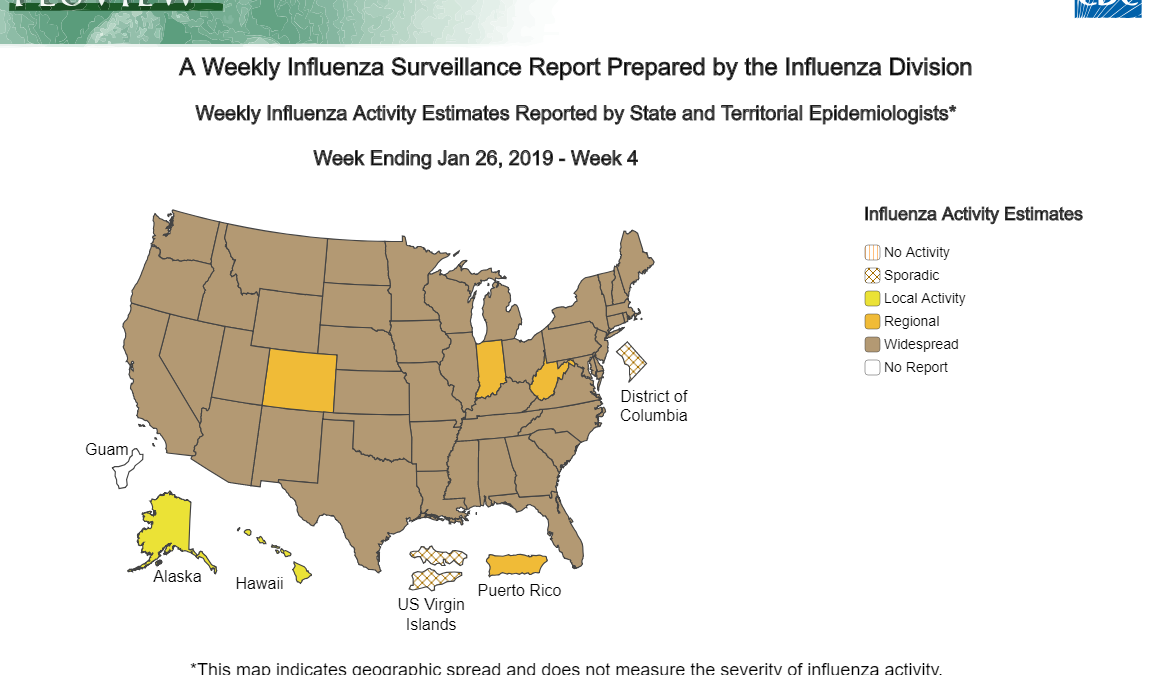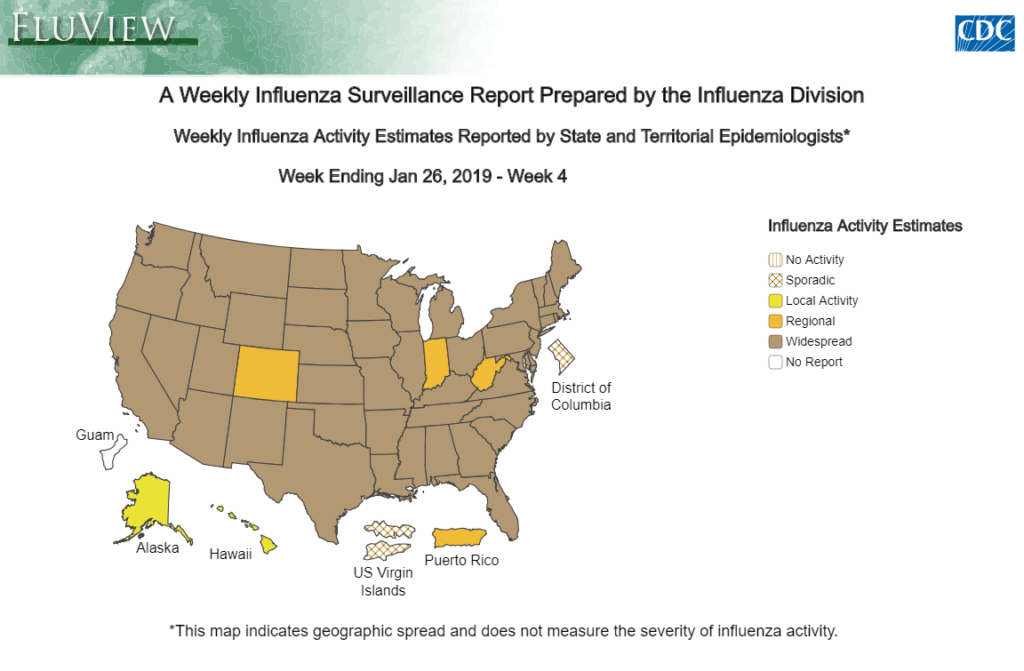
According to this week’s FluView report, seasonal influenza activity rose again over last week, with the number of states reporting widespread activity increasing from 36 to 45. Deaths attributed to pneumonia and influenza (P&I) is at the national threshold this week. P&I has been at or above the epidemic threshold for three consecutive weeks so far this season, however, hospitalization rates remain relatively low compared with last season. CDC also reported another two flu-associated pediatric deaths. H1N1 viruses have been the most commonly identified flu viruses nationally. However, H3N2 viruses have predominated in the southeastern region of the United States.
CDC expects flu activity to remain elevated for a number of weeks. Below is a summary of the key flu indicators for the week ending January 26, 2019:
- Influenza-like Illness Surveillance: For the week ending Jan. 26 (week 4), the proportion of people seeing their health care provider for influenza-like illness (ILI) increased from 3.3% to 3.8%, which is above the national baseline of 2.2%. The highest ILI so far this season was 4.0% during the week ending week ending Dec. 29, 2018.
- All 10 regions reported a proportion of outpatient visits for ILI at or above their region-specific baseline level.
- For comparison purposes, over the past five flu seasons, the peak percent of visits due to ILI has ranged between 3.6% (2015-2016) and 7.5% (2017-2018).
- ILINet data, including national, regional, and select state-level data for the current and previous seasons, can be found at http://gis.cdc.gov/grasp/fluview/fluportaldashboard.html.
- Influenza-like Illness State Activity Indicator Map: The number of states experiencing high ILI increased from 18 states plus NYC to 23 states plus NYC. The 23 states are Alabama, Alaska, Arkansas, Colorado, Connecticut, Georgia, Indiana, Kentucky, Louisiana, Maryland, Massachusetts, Mississippi, Nebraska, New Jersey, New Mexico, North Carolina, Oklahoma, Rhode Island, South Carolina, Texas, Utah, Vermont, and Virginia. Puerto Rico and 10 states (Arizona, Hawaii, Kansas, Minnesota, Missouri, New Hampshire, New York, Pennsylvania, West Virginia, and Wyoming) experienced moderate ILI activity. The District of Columbia and 13 states (California, Florida, Idaho, Illinois, Iowa, Maine, Michigan, Nevada, Oregon, South Dakota, Tennessee, Washington, and Wisconsin) experienced low ILI activity. 4 states (Delaware, Montana, North Dakota, and Ohio) experienced minimal ILI activity. Data was insufficient to calculate an ILI activity level for Puerto Rico. Additional data, including data for previous seasons, can be found at https://gis.cdc.gov/grasp/fluview/main.html.
- Geographic Spread of Influenza Viruses: The number of states reporting widespread influenza activity rose from 36 to 45 states (Alabama, Arizona, Arkansas, California, Connecticut, Delaware, Florida, Georgia, Idaho, Illinois, Iowa, Kansas, Kentucky, Louisiana, Maine, Maryland, Massachusetts, Michigan, Minnesota, Mississippi, Missouri, Montana, Nebraska, Nevada, New Hampshire, New Jersey, New Mexico, New York, North Carolina, North Dakota, Ohio, Oklahoma, Oregon, Pennsylvania, Rhode Island, South Carolina, South Dakota, Tennessee, Texas, Utah, Vermont, Virginia, Washington, Wisconsin and Wyoming). Regional influenza activity was reported by Puerto Rico and three states (Colorado, Indiana, and West Virginia). Local influenza activity was reported by two states (Alaska, and Hawaii). Sporadic influenza activity was reported by the District of Columbia and the U.S. Virgin Islands. Guam did not report. Geographic spread data reflect how many areas within a state or territory are seeing flu activity. Additional data are available at: https://gis.cdc.gov/grasp/fluview/FluView8.html.
- Flu-Associated Hospitalizations: Since October 1, 2018, 4,423 laboratory-confirmed influenza-associated hospitalizations have been reported through the Influenza Hospitalization Network (FluSurv-NET), a population-based surveillance network for laboratory-confirmed influenza-associated hospitalizations covering approximately 9% of the U.S. This translates to a cumulative overall rate of 15.3 hospitalizations per 100,000 people in the United States.
- The highest hospitalization rate is among adults aged 65 years and older (39.8 per 100,000) followed by children younger than 5 years (27.3 per 100,000), and adults aged 50-64 years (20.5 per 100,000). During most seasons, adults 65 years and older have the highest hospitalization rates followed by young children.
- For comparison purposes:
- The final, cumulative overall hospitalization rate for week 4 last season was 57.7 per 100,000.
- Over the past 5 seasons, cumulative end-of-season hospitalization rates have ranged from 31.4 per 100,000 (2015-2016) to 102.8 per 100,000 (2017-2018).
- Additional data, including hospitalization rates during previous influenza seasons, can be found at http://gis.cdc.gov/GRASP/Fluview/FluHospRates.html and http://gis.cdc.gov/grasp/fluview/FluHospChars.html.
- Mortality Surveillance: The proportion of deaths attributed to pneumonia and influenza (P&I) was 7.2% during the week ending January 3, 2019 (week 3). This percentage is at the epidemic threshold of 7.2% for week 3 in the National Center for Health Statistics (NCHS) Mortality Surveillance System. P&I data for week 1 backfilled to 7.0%, which is at the epidemic threshold for that week. P&I has now been at or above the epidemic threshold for 3 weeks so far this season.
- For comparison purposes, over the last five seasons, P&I has been at or above epidemic threshold for a range of four weeks (2015-2016) to 16 weeks (2017-2018).
- Additional P&I mortality data for current and past seasons and by geography (national, HHS region, or state) are available at https://gis.cdc.gov/grasp/fluview/mortality.html
- Pediatric Deaths: Two influenza-associated pediatric deaths were reported to CDC during week 4 (the week ending January 26, 2019).
- Both deaths were associated with an influenza A virus for which no subtyping was performed and occurred during week 3 (the week ending January 19, 2019)
- A total of 24 influenza-associated pediatric deaths have been reported for the 2018-2019 season.
- Additional information on influenza-associated pediatric deaths reported during past seasons, including basic demographics, underlying conditions, bacterial co-infections, and place of death is available on FluView Interactive at: https://gis.cdc.gov/GRASP/Fluview/PedFluDeath.html. More detailed information about pediatric deaths reported during the current season will be available later in the season.
- Laboratory Data:
- Nationally, the percentage of respiratory specimens testing positive for influenza viruses in clinical laboratories during the week ending January 26 was 19.2%, an increase from 15.7% the prior week. This is the highest proportion of specimens testing positive for flu viruses in clinical laboratories this season.
- For comparison purposes, since laboratory data from clinical and public health laboratories was disaggregated three seasons ago, the peak percent of respiratory specimens testing positive for flu at clinical laboratories has ranged from 23.6% to 27.4%.
- Regionally, the three-week average percent of specimens testing positive for influenza in clinical laboratories ranged from 11.3% to 21.9%.
- During the week ending January 26, of the 6,042 (19.2%) influenza-positive tests reported to CDC by clinical laboratories, 5,922 (98.0%) were influenza A viruses and 120 (2.0%) were influenza B viruses.
- The most frequently identified influenza virus type reported by public health laboratories was influenza A(H1N1)pdm09 virus.
- During the week ending January 26, 764 (98.7%) of the 774 influenza-positive tests reported to CDC by public health laboratories were influenza A viruses and 10 (1.3%) were influenza B viruses. Of the 722 influenza A viruses that were subtyped, 179 (24.8%) were H3N2 viruses and 543 (75.2%) were (H1N1)pdm09 viruses.
- The majority of the influenza viruses collected from the United States during September 30, 2018 through January 26, 2019 were characterized antigenically and genetically as being similar to the cell-grown reference viruses representing the 2018–2019 Northern Hemisphere influenza vaccine viruses.
- The vast majority (>99%) of influenza viruses tested showed susceptibility to oseltamivir, zanamivir and peramivir. This week, no new viruses with reduced susceptibility to antiviral drugs were reported. So far this season, two (0.5%) influenza A(H1N1)pdm09 viruses have demonstrated highly reduced antiviral susceptibility to oseltamivir and peramivir. An additional two (0.5%) influenza A(H1N1)pdm09 viruses demonstrated reduced antiviral susceptibility to just oseltamivir. All influenza viruses tested showed susceptibility to zanamivir. FluView is available – and past issues are archived – on the CDC website
- Note: Delays in reporting may mean that data changes over time. The most up to date data for all weeks during the 2018-2019 season can be found on the current FluView and FluView Interactive.

